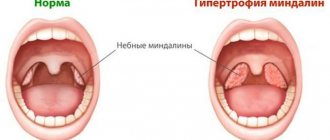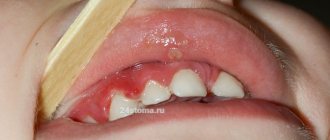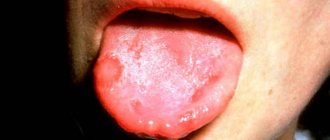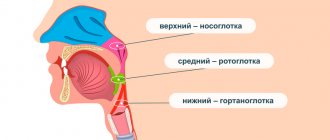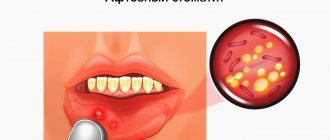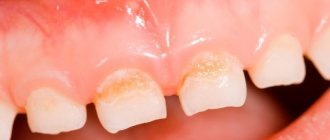Where does red throat come from?
A red throat is hyperemia of the pharyngeal mucosa - a symptom that accompanies various diseases of the pharynx in adults and children. Hyperemia can only be in the area of the arches, tonsils or posterior wall of the pharynx; all areas can also be involved at once, including the soft palate. The process can also be one-sided or two-sided.
But it is worth noting that the assessment of this symptom is sometimes not objective, since it is influenced by the color perception of both the patient and the doctor, and external lighting. Therefore, the patient should consult a doctor in order to carefully collect the entire history of the disease and identify the cause of the red throat.
What to do if a child has a red throat?
A red throat as a symptom is very rarely isolated. It is accompanied by other signs that add up to one or another clinical picture. Only a doctor can correctly assess it and select adequate treatment. Therefore, if your child’s throat is red, you should definitely visit the children’s clinic.
Which doctor should I contact? Of course, to the pediatrician. If necessary, he will refer you to the right specialist, an infectious disease specialist or an ENT doctor.
Treatment of tonsillopharyngitis, which is prescribed by doctors, usually includes general and local therapy. If the disease is caused by bacterial microflora, antibiotics are used1,2,7. For viral infections there is no point in using them: viruses are not sensitive to these drugs2,4,5,7.
Antipyretic drugs based on paracetamol and ibuprofen2,4 approved for children are used as needed, mainly when the temperature rises above 380 C and/or poor heat tolerance1,3.
In local therapy, drugs based on antiseptics1,3,4 are widely used - substances with antimicrobial effects. Preference is given to those forms that are easy to use and have a pleasant taste, which is especially important for children1,5,6.
For local treatment of inflammatory diseases of the pharynx in children over 3 years of age, depending on age, HEXORAL®2,3,4,5,6 preparations can be used. Aerosols and lozenges are especially convenient6,7.
HEXORAL® aerosol with mint flavor is approved for use in the treatment of children over 3 years of age8. It is based on the antiseptic hexetidine, which has a wide spectrum of antimicrobial action, is active against some viruses, and can have a mild analgesic effect8. A convenient bottle with a nozzle allows you to spray the drug evenly over the entire surface of the pharynx.
If a child is over 3 years old and already knows how to gargle, HEXORAL®11 solution can be used for the rinsing procedure. In addition, the solution is suitable for treating the throat with a tampon.
HEXORAL® tablet forms are distinguished by a variety of tastes.
“Mint” HEXORAL® TABS based on the antiseptic chlorhexidine and the local anesthetic benzocaine can complement the traditional therapy of tonsillopharyngitis in children 4 years of age and older9.
HEXORAL® CLASSIC with the flavors of orange, lemon, black currant, lemon and honey with lemon is suitable for children over 6 years old10.
Adolescents over 12 years of age are allowed to use HEXORAL® EXTRA tablets, which, in addition to the antiseptic component, contain the anesthetic lidocaine, which can relieve even severe sore throat12.
If your child is sick, you should consult a pediatrician in any case. Only he is able to determine how to treat the baby, because a red throat can be a symptom of a serious disease.
The information in this article is for reference only and does not replace professional advice from a doctor. To make a diagnosis and prescribe treatment, consult a qualified specialist.
to come back to the beginning
Literature
- I. N. Zakharova, E. B. Machneva. Pediatrician tactics for acute tonsillopharyngitis in children. Medical Council No. 1, 2022 pp. 128-132.
- Zaitseva S.V., Zastrozhina A.K., Kulikova E.V. Acute tonsillitis in the practice of a pediatrician. Medical advice. 2019; 2: 113-119.
- G. A. Samsygina. Acute tonsillopharyngitis in children. Pediatrics2008/Vol. 87/No. 3 pp. 91-95.
- S.A. Karpishchenko, S.I. Alekseenko, S.V. Baranskaya. Treatment of tonsillopharyngitis in children // Medical Council, No. 1, 2022, pp. 70–75.
- Karpishchenko S.A., Lavrenova G.V., Alekseenko S.I., Muratova E.I. Issues of choosing drug therapy for sore throat in children. Pediatrics (Appendix to the journal Consilium Medicum). 2018; 1:39–42. DOI: 10.26442/2413-8460_2018.1.39-42.
- HELL. Vetrova. Acute tonsillitis in children: a pediatrician’s point of view // Pediatric pharmacology. 2014; 11 (2): 61–64.
- Piskunov V.S., Nikitin N.A. Symptomatic treatment of tonsillopharyngitis in acute respiratory viral infection in frequently ill children. Pediatrics. Consilium Medicum. 2019; 1:44–51. DOI: 10.26442/26586630.2019.1.190192.
- Instructions for use of the drug HEXORAL® aerosol: .
- Instructions for use of the drug HEXORAL®TABS: .
- Instructions for use of the drug HEXORAL®CLASSIC: .
- Instructions for use of the drug HEXORAL® SOLUTION: .
- Instructions for use of the drug HEXORAL® TABS EXTRA: .
Anatomy of the pharynx
The pharynx is located behind the nasal and oral cavities; begins at the base of the skull and reaches the lower edge of the 6th cervical vertebra, where it narrows in a funnel-shaped manner and passes into the esophagus.
There are three sections of the pharynx:
- upper – nasopharynx
- middle – oropharynx
- lower – laryngopharynx
Nasopharynx
In the nasopharynx there is an accumulation of lymphoid tissue, which forms the pharyngeal tonsil - adenoids. Also in the nasopharynx are the tubal tonsils, which are located around the pharyngeal openings of the auditory tube.
This part of the pharynx is visualized only with the help of instruments or video endoscopic examination.
Oropharynx
The oropharynx is precisely that part of the pharynx that attracts attention when examined by an otolaryngologist and is accessible for examination by the patient himself.
It is located behind the oral cavity and is delimited by the pharynx. The pharynx is an opening formed above by the soft palate and uvula, on the sides by the anterior and posterior arches, and below by the root of the tongue. Between the anterior and posterior palatine arches there are another lymphoid accumulations - the palatine tonsils.
The palatine tonsils, arches, and uvula are subject to friction at the time of swallowing, due to which their mucous membrane may appear redder (hyperemic), in contrast to the entire oral cavity, gums, etc. But this is just a physiological factor.
The mucous membrane of the posterior pharyngeal wall contains elements of lymphoid tissue that visually resemble granules. The mucous membrane of the oropharynx has a dense network of vascular and lymphatic capillaries with rich sensory innervation, and therefore pathological processes are accompanied by symptoms - pain and discomfort in the throat, sensations of dryness, etc.1
hypopharynx
The laryngopharynx begins at the level of the upper edge of the epiglottis and passes into the initial part of the esophagus.
This part is also visualized only using instrumental and video endoscopic methods. This area is visually inaccessible to the patient.
Diseases of the oral mucosa are accompanied by various pathomorphological changes. Inflammation is one of the most common pathological processes of the mucous membrane of the mouth and pharynx and is a manifestation of the body’s protective reaction to the influence of a pathogenic factor. The course and outcome of the inflammatory process depends on the reactivity of the body, localization, activity and duration of action of the pathogenic factor.2
Causes of a red throat
| CAUSES | A COMMENT | ||
| causes: | Infectious causes | a comment: |
|
| causes: | Non-infectious causes | a comment: |
|
In 70% of cases, inflammation of the pharyngeal mucosa is caused by ARVI viruses (rhinoviruses, adenoviruses, coronaviruses, influenza and parainfluenza viruses), as well as other viruses (enterovirus, herpes virus, Epstein-Barr virus for infectious mononucleosis, and others).
The cause of inflammation can be bacteria:
- group A beta-hemolytic streptococcus (GABHS)
- Staphylococcus aureus
- Streptococcus pneumoniae
- Haemophilus influenza
It should be remembered that a red throat can be a manifestation of infectious diseases such as measles, scarlet fever, and rubella. In some cases, differential diagnosis with other infectious diseases is required.
What to do if the redness does not go away
It happens that a child has a constantly red throat. Most likely, chronic tonsillitis is occurring here - a disease that occurs as a result of untreated or improperly treated tonsillitis.
In the stage of stable remission, the red throat due to tonsillitis does not hurt, the child does not experience any discomfort. During this period, medications are not indicated. It is necessary to direct efforts to strengthen children's immunity, and this is achieved through hardening, balanced nutrition and normalization of the regime. During periods of exacerbation, consultation with a pediatrician is mandatory. Indeed, under the guise of exacerbation of chronic tonsillitis, a variety of pathologies can be hidden.
Dear parents!
Remember that only a qualified pediatrician can make an accurate diagnosis, determine the causes and nature of the disease, and prescribe effective treatment. You can make an appointment with our specialists or call a doctor at home by calling 8-800-700-31-69 Grow up healthy and happy!
Diagnosis of red throat
To identify the cause of a red throat, the patient must consult an otorhinolaryngologist (ENT) or therapist.
If a child has a red throat, a pediatrician’s consultation is necessary.
To identify lesions of the oropharynx, certain rules must be followed. First of all, the inspection requires sufficient lighting (fluorescent lamp, frontal reflector, etc.). The doctor carefully collects anamnesis to make the correct diagnosis.
An otorhinolaryngologist may prescribe a consultation with other specialists: a gastroenterologist, a dentist, and others.
Various laboratory tests are performed: bacteriological examination (culture from the back of the throat and tonsils and PCR), blood tests (complete blood count, ESR, C-reactive protein).
What to do and who to contact?
If your child has a red throat, you need to visit a doctor in a timely manner. You can call a pediatrician at home if redness of the mucous membranes of the throat is accompanied by a deterioration in the baby’s general condition.
A red throat and fever in a child are a pathological duo of symptoms, most often caused by the introduction of an infection into the body. The pediatrician will determine whether it is viral or bacterial. You should know that with some diseases, such as scarlet fever, measles, etc., a rash appears on the skin of children, and with stomatitis of various etiologies, elements of the rash can also be located on the mucous membranes in the mouth. It is difficult to understand this painful diversity on your own, so you should not rely on your knowledge in treating colds. Only pediatricians can make a correct diagnosis.
The first medical authority is the pediatrician’s office. It is he who will determine whether you need additional consultations with a pediatric otolaryngologist or allergist, and if necessary, will write a referral to them.
